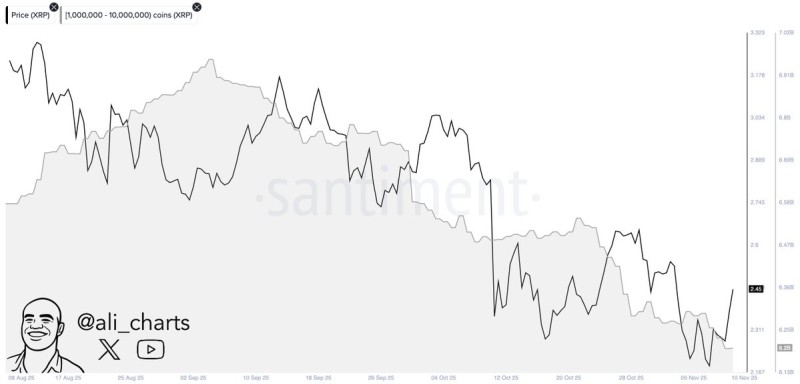XRP (Ripple) is entering a tough stretch as blockchain data reveals intensifying selling from big holders. Recent analysis shows whale wallets have sharply trimmed their positions while the token's price keeps sliding. This combination points to waning confidence among large players right when crypto market volatility is picking up.
Massive Whale Sell-Off in 72 Hours
On-chain data shows that wallets holding between 1 million and 10 million XRP sold nearly 90 million tokens within just 72 hours. This significant reduction highlights a clear distribution pattern among major holders at a time when XRP already shows technical weakness.

The data supports this through a synchronized decline in both whale holdings and price from August through early November. Each time the price tried to recover, whales kept selling into the rallies instead of buying more.
Price Charts Confirm Multi-Month Decline
The price chart reveals a persistent downtrend with lower highs and lower lows dominating the structure. A sharp mid-October drop was followed by more deterioration. By November 10, XRP trades near $2.45, confirming a multi-month slide. Meanwhile, whale holdings peaked in late August and steadily declined from September onward. The pronounced drop in early November lines up perfectly with the 90 million token sell-off.
Whale Behavior Drives Market Weakness
This parallel movement between whale balances and price suggests that large holder selling has been a key driver behind XRP's downward momentum. When whales reduce exposure over extended periods like this, market structure typically weakens further.
Why Are Whales Selling Now?
Several factors likely explain why whales are selling. Ongoing regulatory uncertainty around XRP continues limiting institutional participation. Rising Bitcoin dominance is pulling liquidity away from altcoins. The lack of strong ecosystem updates or catalysts reduces demand-side support. Plus, risk-off sentiment in global markets is prompting major holders to trim volatile assets. Whales often move ahead of broader market participants, making their behavior an important early warning signal.
 Alex Dudov
Alex Dudov

 Alex Dudov
Alex Dudov

